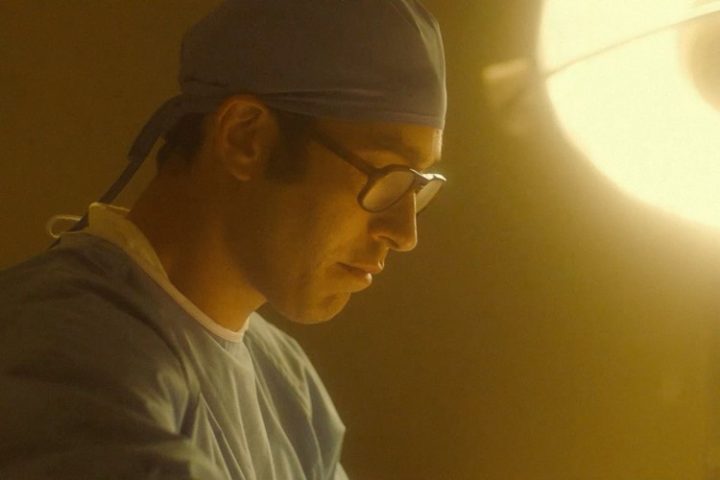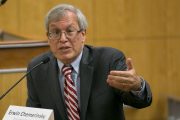
Forty-eight years ago, the U.S. Supreme Court voted 7-2 in favor of Roe, in the landmark case Roe v. Wade, legalizing abortion on demand in America. Finally, a thought-provoking film chronicling the infamous 1973 decision has arrived.
Steeped in research, the movie Roe v. Wade deftly combines the historical details of the unprecedented ruling with the complex portrait of a man swept up in the zeitgeist of 1960s and 1970s America.
Cowritten, codirected, and coproduced by Cathy Allyn (The Experiment) and Nicholas Loeb (Primary Colors), this low-key, carefully paced drama largely accomplishes what it sets out to do: to present all the facts, allowing viewers to decide on which side of the abortion issue they fall.
Narrated by Dr. Bernard Nathanson (Nicholas Loeb), the story is one of power, greed, and corruption. It is also about hubris, the pursuit of personal interests and fame under the guise of a massive crusade to “help women.”
The film opens and closes in March 1985. Nathanson is giving an interview to an obviously bewildered Washington Post reporter, who questions what seem to be contradictory statements from the doctor. This scene illustrates well the beginning as well as the end of Nathanson’s career as America’s worst abortionist of that time.
Reporter: [Referring to the aborted children] “When you take them out, you don’t see anything?”
Nathanson: “No, you don’t see anything. Well, I mean, of all the thousands of second trimester abortions I’ve done, maybe I’ve seen half a dozen.”
Reporter: “But didn’t it bother you when you did?”
Nathanson: “No, not particularly, it was the end product, a lifeless limp thing lying there.”
Reporter: “They have a human form.”
Nathanson. “Oh absolutely.”
Reporter: “I’m a little confused. First you said, all you see is ‘bloody meat,’ but now you say you always thought it was a person. So, which one is it?”
Although Nathanson’s demeanor appears calm and cold, his statements are consistent with real-life documented conversations. This is the man he has become after presiding over more than 60,000 abortions spanning a decade. His journey to committing his life to “saving women” begins after he pays for a back-alley abortion for a girlfriend he’d hoped to marry, a decision that destroyed their relationship but led to what he describes as “the start of a revolution. Women are dying…. I’m saving lives!”
The real mastermind, however, behind the plot to make abortion on demand legal across the country, beginning in New York, is Larry Lader (Jamie Kennedy), dubbed “the father of the abortion movement.” Lader, who was mentored by Planned Parenthood founder and eugenicist Margaret Sanger in the 1920s, aspires to continue Sanger’s work. He recruits Nathanson and the leader of the women’s movement, feminist Betty Friedan (Lucy Davenport), to launch the nation’s first organization for legalizing abortion, the National Association to Repeal Abortion Laws (NARAL).
Money and power drive Lader’s ambitions. He is visibly thrilled at the fervent enthusiasm of the women in the movement. In Nathanson’s 1979 book, Aborting America, is the spooky jingle sung gleefully by Lader’s and Nathanson’s wives and children in the film called the “Abortion Song.” Its lyrics, composed by Nathanson, relate the grim truth about abortion.
“There’s a fortune in abortion — just a twist of the wrist and your through….
The population of the nation won’t grow if it’s left up to you….
Lader’s mission is simple: Find a pregnant girl to challenge the abortion laws, and “when New York falls the country falls.”
Dr. Mildred Jefferson (Stacey Dash), Nathanson’s compelling if underdeveloped foil (perhaps this was deliberate?), arrives on the scene early but is noticeably absent for the next 40-plus minutes of the film. The first black woman to graduate from Harvard Medical School, Jefferson would go on to become president of the National Right to Life Foundation and influence President Ronald Reagan’s pro-life views.
Approached by Catholic priest James McHugh (Tom Guiry) to head the National Right to Life committee, she initially declines but is pressed further by McHugh, who says, “[Abortion] is akin to slavery, and you know the topic.” Jefferson retorts, “Because I’m black?” “Yes,” he replies. Eventually, she signs on to the group, befriending law professor Robert Byrn (Joey Lawrence), who is perhaps the most charismatic and convincing character of the entire film, with an endearing penchant for quoting political and literary luminaries such as Ben Franklin, Oliver Wendall Holmes, and John Marshall.
Throughout, the pro-life movement is depicted as sincere but quiet, lacking in funds, support, and the enthusiasm of the pro-abortion side. Archival footage of massive protests demonstrates the burgeoning 1960s women’s liberation movement. Lader’s articulation of the slogan “pro-choice” is nothing short of ingenious, a message few were willing to oppose. At the height of the sexual revolution, women were caught up in the idea of their right to control their own bodies; they appear to show no concern that they are in fact killing their own children.
As with the admission by Nathanson confessing that he lied about knowing the aborted fetus was a human being, the movie makes clear that lies are what advance the entire pro-abortion movement. Lader proves especially adept at conjuring falsehoods, which even Time magazine willingly prints, such as that “every year, a million back-alley abortions claim thousands of women’s lives.”
In one revealing scene, while vacationing in St. Lucia, Nathanson and Lader are boasting to a young and beautiful bikini-clad woman about what they’ve done. She asks why they would lie about such things. Nathanson, who at this point is raking in $50,000 a day, tells her, “If you keep repeating the big lie, people don’t question it.”
Buying the lie, abortion clinics are filled with eager young women, sometimes up to eight to a room, awaiting their turn to be “treated” by the abortionist. Notably, none of these women are black. Given Sanger’s views, as proposed in “The Negro Project,” to reduce the black population and literally stop black people from having children altogether, and that black women make up 40 percent of all abortions in America, this is an interesting choice on the part of the filmmakers.
Texas lawyers Linda Coffee (Justine Wachsberger) and Sarah Weddington (Greer Grammer), who deserve plaudits for delivering outstanding performances, were the willing pawns of the “pro-choice” cause. Unemployed and having never tried a case before Roe, they bask in their rise from rags to riches.
One of the film’s greatest strengths is its intimate portrayal of the political and personal influences impacting the decisions of the Supreme Court justices, a group commonly revered as impeccable men without flaws. According to the film, Justices Potter Stewart (William Forsythe) and Harry Blackmun (Corbin Bernsen) unashamedly have family members who work at Planned Parenthood, creating a clear conflict of interest. When Stewart is confronted by Justice William Brennan (Robert Davi), who demands Stewart recuse himself, Stewart refuses. To avenge Chief Justice Warren Burger (Jon Voight) for demanding Roe be reargued after an internal vote of 4-3 in favor of Roe, Justice William Douglas (Richard Portnow) admits to Brennan that he’s going to leak the internal vote to the press.
As each judge wrestles with his decision, the film emphasizes the pressures they face from outside forces, whether a fear of damaging established political alliances or losing the favor of family members. While sitting around the dinner table, Blackmun’s own daughter tells him, “Stand with us, Daddy, stand up for women.”
As depicted, all of the judges had strong feelings about the way the vote should go. Burger uses his position as chief justice to demand Roe be reargued, a move several of the other justices resent. To attack Burger publicly, Douglas and Stewart coordinate an organized effort to leak information about the court’s internal vote to a Washington Post reporter played by the inimitable Roger Stone. When Stone is shocked at the leak, Stewart is defiant, and states, “He [Burger] deserves it.”
In December 1971, when Roe was first heard by the High Court, only seven justices sat on the bench, as President Richard Nixon struggled to get his two picks confirmed in the Senate to fill vacant seats. Burger is perhaps the most tragic figure. Knowing abortion is legally and morally wrong, he ultimately falls prey to perceived public opinion and flips his vote from no to yes for Roe. Byron White (John Schneider) is the only justice unwavering in his commitment to life, and, with Justice William Rehnquist, votes no.
Now, a question that will plague viewers is: Where and who is Jane Roe? As a character, the twenty-something Norma McCorvey, the real-life Roe, is given less than 10 minutes of screen time. In fact, viewers learn very little about her or the actual case, until Professor Byrn gets us thinking by raising some obvious questions during a college lecture: “Why was Roe in the Supreme Court? There’s no factual record in this case, no trial, no expert witnesses, no description of evidence, no expert witness testimony…. This is a conspiracy.”
One could argue the conspiracy of which Byrn speaks is that the case has nothing to do with women’s healthcare or well-being but instead money and power for Planned Parenthood and abortionists.
As attentive viewers will recall, the case was initially filed in Houston, even though McCorvey lived in Dallas. Planned Parenthood lawyer Linda Coffee arranges this so that Dallas Judge Sarah Hughes, who favors the position of Roe, will oversee the hearing. McCorvey never appears in court; she never even has an abortion. Meanwhile, Judge Hughes’s archrival, Texas District Attorney General Henry Wade, takes one look at the case and states emphatically, “No judge or jury in their right mind would ever let abortion happen in Texas.”
In court, Assistant District Attorney Jay Floyd argues that the child’s right to life is superior to the woman’s right to privacy. Conversely, Weddington asserts it’s impossible to determine “when life begins or even ends.” She garners a standing ovation after stating the crux of the pro-abortion claim in an impassioned closing argument: “These young girls, who cannot possibly shoulder the responsibility of a child, should be entitled to an abortion!” Though the state of Texas loses the case, a furious Wade proclaims, “I will appeal this all the way to the Supreme Court so help me God!”
Well illustrated throughout are the parallels of the cultural issues dividing America both then and now, as well as the manipulation of the media and the proliferation of the Larry Laders of the world among today’s progressive Left. American society today and the Roe controversy are deeply similar, and this fact will not be lost on conservative or leftist viewers. For instance, having the same effect today as the phrase “women’s choice” is the slogan “Black Lives Matter,” a message that on its face sounds good, but in reality riles up the passions of the people for reasons that advance the interests and profits of a small few.
Aside from a 1989 TV movie starring Holly Hunter, Allyn and Loeb’s film may be the seminal account (so far) on the landmark ruling. In an interview with The New American, Allyn stressed that the film had zero support from Hollywood. “We reached out to everyone we could think of from pro-life and religious groups.” Moreover, members of the cast included “an equal breakdown of actors from the pro-life and pro-choice movements, brought together to document the history of the ruling,” said Allyn. One wonders if, over the course of filming, whether hearts and minds were changed on the controversial issue.
The haunting question that begins the film, whether an aborted fetus is really a human being, is answered by the end, as Nathanson is struck by a powerful epiphany, as he looks at the ultrasound for the first time and sees the child moving in the womb and hears the beating of the human heart. In that moment, he weeps unconsolably because he has killed his own child.
Notably, a very different Nathanson is depicted at the end of the movie, when the now-pro-life champion is baptized into the Catholic Church. That someone who could kill so many babies could have a change of heart and work so diligently for the pro-life cause is miraculous. In 1984, before his religious conversion, Nathanson had already become pro-life. In that year he had created the antiabortion film “The Silent Scream,” depicting an abortion-in-progress via ultrasound imaging. If Nathanson could be converted, it seems anyone could be converted.
The question remains, however, will this new film convince viewers of the abomination of abortion? For decades, Americans have been deceived, thinking abortion is about caring for women. Sadly, it is only about power and greed. We have normalized murder by dehumanizing the preborn child. Since 1973, more than 60 million babies have been aborted, and 40 percent of those deaths are in the black community. In 2020, the profits of Planned Parenthood exceeded more than $1.6 billion, according to the film.
Undoubtedly, the untold story of Roe v. Wade is long overdue. Yet it is here now, and in the words of the film’s executive producer Dr. Alveda King, it “proves that Hollywood does not have the final word about the sanctity of life.”
Currently, screenings are playing across the country, with the premier showing on February 26 at the CPAC conference in Orlando.
On April 2, the film will be released to the general public through Amazon Prime and iTunes.
Correction: Initially, this article stated that the final vote in Roe v. Wade was 5-4, not 7-2.




